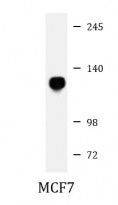ARG55092
anti-DDR1 antibody
anti-DDR1 antibody for Western blot and Human
Cancer antibody; Cell Biology and Cellular Response antibody; Neuroscience antibody
Overview
| Product Description | Mouse Monoclonal antibody recognizes DDR1 |
|---|---|
| Tested Reactivity | Hu |
| Tested Application | WB |
| Host | Mouse |
| Clonality | Monoclonal |
| Clone | 1464CT339.1.54 |
| Isotype | IgG2b, kappa |
| Target Name | DDR1 |
| Antigen Species | Human |
| Immunogen | Human DDR1 Recombinant protein. |
| Conjugation | Un-conjugated |
| Alternate Names | PTK3; Discoidin receptor tyrosine kinase; PTK3A; CAK; Tyrosine-protein kinase CAK; NEP; NTRK4; Epithelial discoidin domain-containing receptor 1; HGK2; Protein-tyrosine kinase RTK-6; TRKE; EDDR1; DDR; Tyrosine kinase DDR; CD167 antigen-like family member A; MCK-10; CD antigen CD167a; Protein-tyrosine kinase 3A; TRK E; CD167; Cell adhesion kinase; RTK6; Epithelial discoidin domain receptor 1; MCK10; EC 2.7.10.1; Mammary carcinoma kinase 10 |
Application Instructions
| Application Suggestion |
|
||||
|---|---|---|---|---|---|
| Application Note | * The dilutions indicate recommended starting dilutions and the optimal dilutions or concentrations should be determined by the scientist. | ||||
| Positive Control | MCF7 |
Properties
| Form | Liquid |
|---|---|
| Purification | Purification with Protein G. |
| Buffer | PBS and 0.09% (W/V) Sodium azide |
| Preservative | 0.09% (W/V) Sodium azide |
| Storage Instruction | For continuous use, store undiluted antibody at 2-8°C for up to a week. For long-term storage, aliquot and store at -20°C or below. Storage in frost free freezers is not recommended. Avoid repeated freeze/thaw cycles. Suggest spin the vial prior to opening. The antibody solution should be gently mixed before use. |
| Note | For laboratory research only, not for drug, diagnostic or other use. |
Bioinformation
| Database Links |
Swiss-port # Q08345 Human Epithelial discoidin domain-containing receptor 1 |
|---|---|
| Gene Symbol | DDR1 |
| Gene Full Name | discoidin domain receptor tyrosine kinase 1 |
| Background | Receptor tyrosine kinases play a key role in the communication of cells with their microenvironment. These kinases are involved in the regulation of cell growth, differentiation and metabolism. The protein encoded by this gene belongs to a subfamily of tyrosine kinase receptors with homology to Dictyostelium discoideum protein discoidin I in their extracellular domain, and that are activated by various types of collagen. Expression of this protein is restricted to epithelial cells, particularly in the kidney, lung, gastrointestinal tract, and brain. In addition, it has been shown to be significantly overexpressed in several human tumors. Alternatively spliced transcript variants encoding different isoforms have been described for this gene. [provided by RefSeq, Feb 2011] |
| Function | Tyrosine kinase that functions as cell surface receptor for fibrillar collagen and regulates cell attachment to the extracellular matrix, remodeling of the extracellular matrix, cell migration, differentiation, survival and cell proliferation. Collagen binding triggers a signaling pathway that involves SRC and leads to the activation of MAP kinases. Regulates remodeling of the extracellular matrix by up-regulation of the matrix metalloproteinases MMP2, MMP7 and MMP9, and thereby facilitates cell migration and wound healing. Required for normal blastocyst implantation during pregnancy, for normal mammary gland differentiation and normal lactation. Required for normal ear morphology and normal hearing (By similarity). Promotes smooth muscle cell migration, and thereby contributes to arterial wound healing. Also plays a role in tumor cell invasion. Phosphorylates PTPN11. [UniProt] |
| Cellular Localization | Isoform 1: Cell membrane; Single-pass type I membrane protein Isoform 3: Secreted. |
| Research Area | Cancer antibody; Cell Biology and Cellular Response antibody; Neuroscience antibody |
| Calculated MW | 101 kDa |
| PTM | Autophosphorylated in response to fibrillar collagen binding. Glycosylation of Asn-211, but apparently not of Asn-260, Asn-371, or Asn-394, prevents autophosphorylation from occurring in the absence of collagen. |
Images (1) Click the Picture to Zoom In






